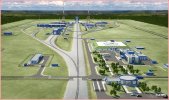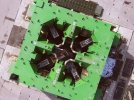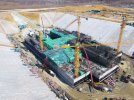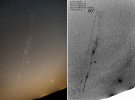Install the app
How to install the app on iOS
Follow along with the video below to see how to install our site as a web app on your home screen.
Note: This feature may not be available in some browsers.
You are using an out of date browser. It may not display this or other websites correctly.
You should upgrade or use an alternative browser.
You should upgrade or use an alternative browser.
Avaruus
- Viestiketjun aloittaja Juke
- Aloitus PVM
Webb is beginning to resemble the form it will take when it is fully deployed - now that the mission operations team has successfully deployed and latched into place the observatory's forward and aft Unitized Pallet Structures.
The team began working through the deployment of the forward pallet this morning, concluding at approximately 1:21 p.m. EST. The team then moved on to the aft pallet deployment, completing the process at approximately 7:27 p.m. EST. While the actual motion to lower the forward pallet from its stowed to its deployed position took only 20 minutes, and the lowering of the aft pallet took only 18 minutes, the overall process took several hours for each because of the dozens of additional steps required.
These include closely monitoring structural temperatures, maneuvering the observatory with respect to the sun to provide optimal temperatures, turning on heaters to warm key components, activating release mechanisms, configuring electronics and software, and ultimately latching the pallets into place.
The unfolding of the pallets marks the beginning of Webb's major structural deployments and also the beginning of the sunshield deployment phase - which will continue through at least this Sunday, Jan. 2.
The planned timeline of these deployments is laid out here but could change as the operations team gets deeper into the schedule.

Webb Telescope Aft Sunshield Pallet Deployed
Washington DC (SPX) Dec 29, 2021 - Webb is beginning to resemble the form it will take when it is fully deployed - now that the mission operations team has successfully deployed and latched into place the observatory's forward and af
www.spacedaily.com

If all goes according to plan, the telescope will be fully deployed 13 days after launch, around Jan. 7, and will reach its final orbit 29.5 days after launch. Next, the observatory will undergo five months of commissioning to prepare its instruments and mirror for science work, which is expected to begin in the summer of 2022.

Where is NASA's James Webb Space Telescope? Here's how to follow its progress.
What's the massive observatory doing now? Here's how to find out.
Viimeksi muokattu:
fulcrum
Greatest Leader
Ai saivat taivaalle, oli niin vähällä huomiolla että ajattelin sen siirtyvän taas. Itse raketti toimi taas mutta Persein kokeilu meni näköjään perseilleen. Lastina oli vain valurautaa joten mitään arvokasta ei menetetty mutta hommat varmaan vähän viivästyy. Pitää niiden ylävaiheidenkin toimia että saadaan kamaa kiertoradalle.
Russia launches third and final Angara A5 demonstration mission - NASASpaceFlight.com
Russia has launched its third and final demonstration flight of the Angara A5 rocket on…www.nasaspaceflight.com
Vähän hassua että noita laukaistaan Plesetskistä, joka on kuitenkin aika epäedullinen paikka muille kuin polaari- ja molnijaradoille. Baikonurista riippuvuutta halutaan tietenkin vähentää mutta olisiko ollut fiksumpaa keskittää laukaisut Vostotshnyihin josta tulee vähemmän penalttia?
Vähän hassua että noita laukaistaan Plesetskistä, joka on kuitenkin aika epäedullinen paikka muille kuin polaari- ja molnijaradoille. Baikonurista riippuvuutta halutaan tietenkin vähentää mutta olisiko ollut fiksumpaa keskittää laukaisut Vostotshnyihin josta tulee vähemmän penalttia?
Ei siellä ole vielä tuolle alustaa.
Vostochny begins work on a second launch pad set to host Angara rockets
https://www.nasaspaceflight.com/2019/09/vostochny-work-second-launch-pad-angara/Tältä vissiin pitäisi näyttää.
Angara launch complex (371SK32) in Vostochny

Tämän mukaan ensimmäinen laukaisu 2023.
According to the head of Roscosmos Dmitry Rogozin, the launch table for the Angara rocket on Vostochny has been successfully assembled. The first launch of this type of carrier from the cosmodrome was scheduled for 2023.
https://vpk.name/en/552921_russia-h...a-launch-pad-at-the-vostochny-cosmodrome.html
Kuvia rakennutyömaalta.
Launch table



NASA said Wednesday that it is now targeting "mid-February" for an initial rollout of the Space Launch System rocket to the launch pad.
The space agency set the new date after engineers and technicians successfully removed a faulty engine controller from one of the four space shuttle main engines that power the massive rocket. An engine controller is basically a flight computer that communicates between the engine and the rocket; this one had failed communication tests in late November.
At present, NASA engineers, alongside contractor teams who have built various components of the rocket, are working to complete all remaining SLS preflight diagnostic tests and hardware close-outs prior to rolling the fully stacked rocket to the launch pad at Kennedy Space Center.

The launch of NASA’s titanic SLS rocket slips toward summer 2022
The rocket will now roll out of its Florida hangar no earlier than mid-February.
 arstechnica.com
arstechnica.com
Ehkä, en kuitenkaan laittaisi vetoa sen puoleen että SLS pääsee minnekkään tänä vuonna. Tarkoitus olisi mutta viivästys on vuosia jäljessä.
fulcrum
Greatest Leader
Joo, ihmettelen vaan hiukan tätä hajauttamista. Wikipedian mukaan muuten Baikonuristakin kaavaillaan Angara-laukaisuja sitten kun Protonista aika jättää. Kazakstanhan ei vastusta rakettien laukaisua, muttei pidä Protonista jossa on myrkyllisiä polttoaineita.Ei siellä ole vielä tuolle alustaa.
Vostochny begins work on a second launch pad set to host Angara rockets
https://www.nasaspaceflight.com/2019/09/vostochny-work-second-launch-pad-angara/
Tältä vissiin pitäisi näyttää.
Angara launch complex (371SK32) in Vostochny
Katso liite: 55417
Tämän mukaan ensimmäinen laukaisu 2023.
Meanwhile,

...sillä NASA on ilmoittanut että Ariane tuuppasi James Webbin niin tarkasti radalleen ettei likikään kaikkia etukäteen laskettuja korjauspolttoja tarvittu. Teleskoopille jäi nyt "huomattavasti enemmän" polttoainetta kuin mitä on laskettu tarvittavan toivottuun 10 vuoden käyttöikään. Koska 'skooppi oli niin tolkuttoman kallis, niin jokainen lisäkuukausi tuijotusaikaa on kullan arvoista. L2-piste ei ole täysin stabiili vaan siellä pysyminen edellyttää pieniä korjauspolttoja silloin tällöin, ja 1.5 miljoonan kilsan päähän ei ihan heti päästä laitetta tankkaamaan.
Laukaisun aikana kommentaattorit kiinnittivät huomiota aurinkopaneelin paljon odotettua aikaisempaan levittymiseen, melkein heti irrottautumisen jälkeen. Tämä johtui juurikin Arianen tarkkuudesta, koska paneeli oli ohjelmoitu levittymään automaattisesti heti kun tietyt rataparametrit toteutuivat.
Apupeili on avattu, pääpeilin avaus on muutaman päivän päästä, sen jälkeen pahimman hikoilun pitäisi olla takanapäin...
En nyt muista lähdettä, mutta jossakin sanottiin, että tuosta Vostochnysta pitäisi tulla siviili/kaupallisten rakettien "pää" paikka kun taas pletsekistä valtion rakettien.Joo, ihmettelen vaan hiukan tätä hajauttamista. Wikipedian mukaan muuten Baikonuristakin kaavaillaan Angara-laukaisuja sitten kun Protonista aika jättää. Kazakstanhan ei vastusta rakettien laukaisua, muttei pidä Protonista jossa on myrkyllisiä polttoaineita.
Jos tuo nyt pitää paikkaa niin kai sillekin joku oikea syy on.
Rocket engineers at Gilmour Space Technologies have greeted the new year with a successful 110-kilonewton test fire of the most powerful rocket engine ever developed in Australia.
The 75-second test was a major milestone for Gilmour Space, which is developing Australian Made rockets that will, over the next five years, be capable of launching 300- to 4,000-kilogram satellites and payloads into low earth and other orbits.
"What you see here is the main engine that will power the first and second stages of our three-stage Eris rocket to space," explained company CEO, Adam Gilmour.
"It was a successful test. We achieved our expected full thrust of 110 kilonewtons (or 25,000 pounds-force) over the 75 seconds, and our team will be moving on to the final engine qualification campaign next month."
Strategically, the test was also a demonstration of Australia's first sovereign launch capability. "It is no small thing to say that we've developed Australia's largest rocket engine; and that it could have significant flow-on benefits for the commercial, civil and defence space sectors," he added.
On where and when Eris will be launched, Mr Gilmour said the company was currently seeking approvals from state and federal government agencies to green light a small orbital spaceport at the Abbot Point State Development Area in Bowen, North Queensland.
"With timely assessments and approvals from relevant authorities, we hope to be able to launch Australia's first sovereign-made rocket from Queensland sometime in the latter half of 2022."

Gilmour Space fires up for 2022 with Australia's largest rocket engine test
Gold Coast, Australia (SPX) Jan 11, 2022 - Rocket engineers at Gilmour Space Technologies have greeted the new year with a successful 110-kilonewton test fire of the most powerful rocket engine ever developed in Australia. The 75-secon
www.spacedaily.com
"When we launched, by design our limiting resource is propellant," Bill Ochs, the Webb project manager, told reporters in the livestreamed press conference, which was hosted by the NASA Goddard Space Flight Center in Maryland.
He paid tribute to the super-precise launch that an Arianespace Ariane 5 heavy-lift rocket executed as it hefted Webb to space from French Guiana on Dec. 25.
"Right now, because of the the efficiency or the accuracy with which Ariane 5 put us on orbit, and our accuracy and effectiveness implementing our mid-course corrections, we have quite a bit of fuel margin right now relative to 10 years," Ochs said, speaking of an earlier fuel estimate.
"Roughly speaking, it's [now] around 20 years of propellant, roughly speaking, and that's TBD [to be determined]," he added.
While Ochs did not elaborate on why that is to be determined, one large factor is a looming midcourse correction the telescope is expected to execute in about two weeks to put it on track for its ultimate destination.

James Webb Space Telescope should have fuel for about 20 years of science
Webb will be working for a long, long time, scientists hope.
Elon Musk järjestää sinne turistilentoja silloin.Kysymys saadaanko seuraavan kahdenkymmenen vuoden aikana väsättyä kiertoradalla tankkiasema ja pystytäänkö tekemään vehje joka tankkaa webin?

rty19
Greatest Leader
Elon Muskilla tällainenkin uusi idea

 www.tivi.fi
www.tivi.fi
Elon Musk sai mullistavan liikeidean
Elon Musk haluaa torjua ilmastonmuutosta ja tehdä raketeilleen polttoainetta poistamalla hiilidioksidia ilmakehästä.
StepanRudanskij
Greatest Leader
Paketti on levitetty. Kun vaan tietokoneet futaa niin...
James Webb Space Telescope should have fuel for about 20 years of science
Webb will be working for a long, long time, scientists hope.www.space.com
Astronomers rejoice! Webb Telescope's honeycomb mirrors are now fully deployed
Of the many steps before we see the first images from the James Webb Space Telescope, this milestone was one of the most critical to the mission.
Enää vain puolen vuoden mittainen näöntarkastus ja peilien säätö. Sen jälkeen on luvattu esitellä kuvia "wow"-laadulla.Paketti on levitetty. Kun vaan tietokoneet futaa niin...

Astronomers rejoice! Webb Telescope's honeycomb mirrors are now fully deployed
Of the many steps before we see the first images from the James Webb Space Telescope, this milestone was one of the most critical to the mission.www.yahoo.com


